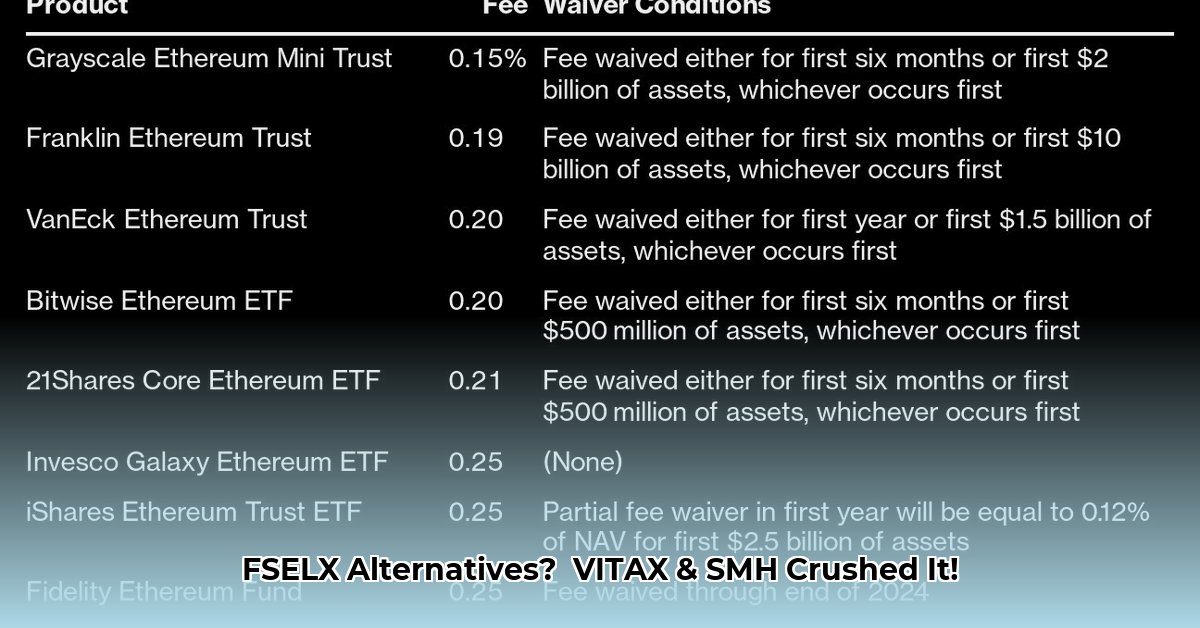
FSELX ETF Equivalent: Exploring VITAX and SMH
Considering alternatives to Fidelity's Select Semiconductors Portfolio (FSELX)? This comparative review analyzes FSELX against two leading contenders: Vanguard's Information Technology Index Fund Admiral Shares (VITAX) and the VanEck Vectors Semiconductor ETF (SMH). We'll assess performance, costs, risk, and management styles to help you determine the best fit for your investment strategy.
Performance: Past Returns and Future Outlook
Over the past decade, VITAX and SMH have significantly outperformed FSELX. VITAX exhibited an average annual return of approximately 20.53%, while SMH achieved roughly 25.86%. In contrast, FSELX lagged behind with an average annual return of about 16.53%. While this year's performance mirrors this trend, past performance is not indicative of future results. Market conditions are dynamic, and sector-specific factors can heavily influence investment returns.
Costs: Expense Ratio Analysis
Expense ratios significantly impact long-term returns. VITAX (0.10%) and SMH (0.35%) boast substantially lower expense ratios than FSELX (0.68%). These seemingly small differences accumulate over time, potentially eroding substantial portions of your returns, particularly for long-term investments. Isn't minimizing these costs a key element of maximizing your investment potential?
Risk: Maximum Drawdowns and Volatility
Assessing risk involves examining maximum drawdowns—the largest percentage drop from peak to trough value. SMH (-83%) and FSELX (-82%) exhibit similar maximum drawdowns, suggesting comparable vulnerability to market corrections. However, VITAX's maximum drawdown of approximately -54% indicates potentially lower volatility. While lower volatility doesn't eliminate risk, it suggests a potentially less turbulent investment journey. How much volatility are you comfortable with?
Management Style: Active vs. Passive
VITAX and SMH employ passive management strategies, aiming to track specific market indexes. This approach typically results in lower costs and greater transparency. FSELX, conversely, utilizes active management, where fund managers actively select holdings, aiming to outperform the market. While active management could yield higher returns, it also introduces greater variability and higher fees.
Dividends: Passive Income Generation
VITAX (approximately 0.59%) and SMH (approximately 0.43%) offer modest dividend yields, providing a supplemental income stream. FSELX currently does not distribute dividends. This is a minor factor for many, but could be relevant to income-focused investors.
Comparative Summary
| Factor | VITAX | SMH | FSELX |
|---|---|---|---|
| Return Potential | High | Very High | Moderate |
| Volatility | Lower | Moderate | Higher |
| Expense Ratio | Low | Moderate | High |
| Max Drawdown | Lower | High | High |
| Management Style | Passive | Passive | Active |
| Dividend Yield | Moderate | Moderate | None |
Mitigating High Correlation Risk
The high correlation between FSELX, VITAX (0.87), and SMH (0.95) limits diversification benefits. Holding all three offers minimal risk reduction, as they primarily track similar market trends. Diversifying beyond the semiconductor sector is crucial for managing overall portfolio risk.
Actionable Steps
- Assess your risk tolerance: Higher potential returns come with higher volatility.
- Analyze your investment timeline: Long-term investors may benefit more from lower expense ratios.
- Consider broader diversification: Reduce portfolio risk by investing in other asset classes.
Disclaimer: This analysis is for informational purposes only and does not constitute financial advice. Consult a financial advisor before making any investment decisions.